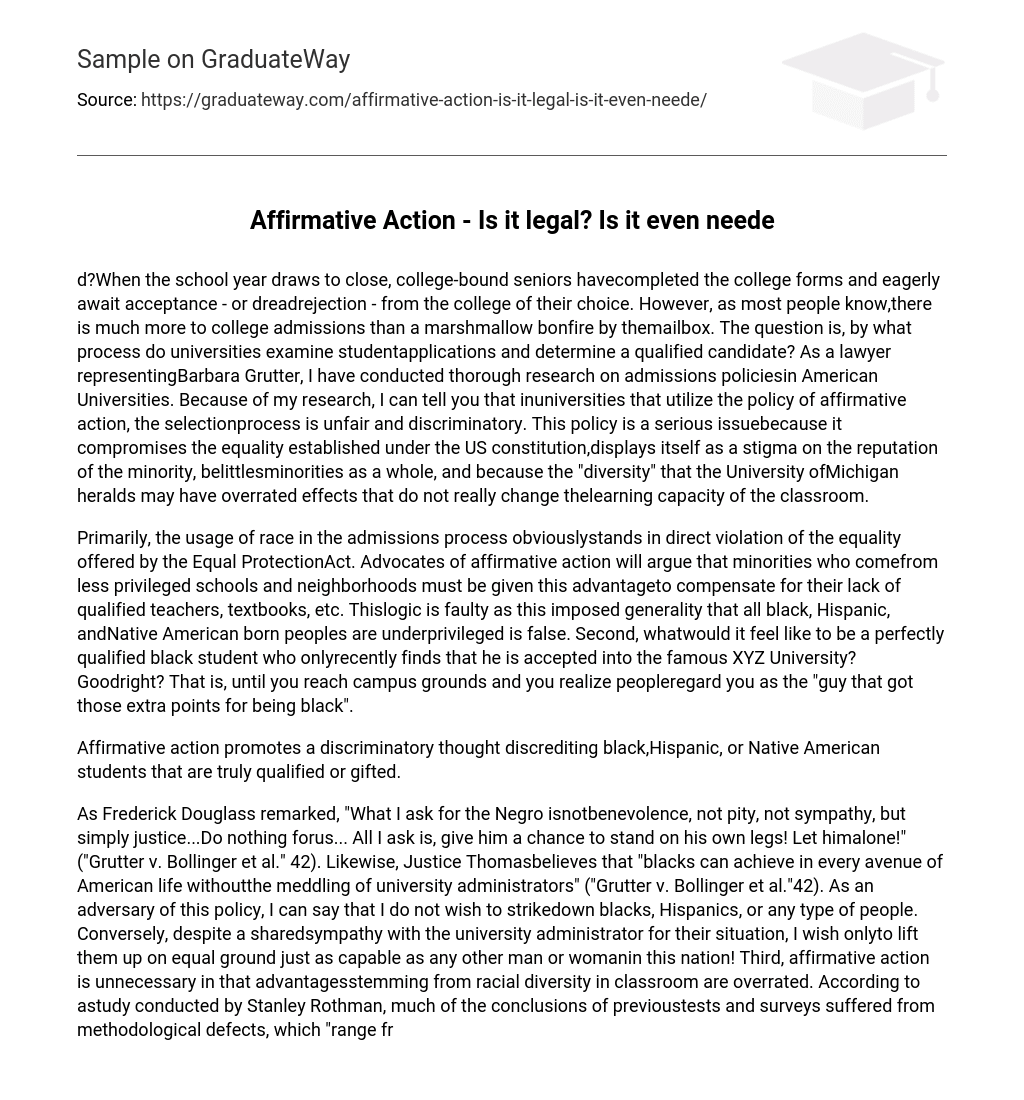d?When the school year draws to close, college-bound seniors havecompleted the college forms and eagerly await acceptance – or dreadrejection – from the college of their choice. However, as most people know,there is much more to college admissions than a marshmallow bonfire by themailbox. The question is, by what process do universities examine studentapplications and determine a qualified candidate? As a lawyer representingBarbara Grutter, I have conducted thorough research on admissions policiesin American Universities. Because of my research, I can tell you that inuniversities that utilize the policy of affirmative action, the selectionprocess is unfair and discriminatory. This policy is a serious issuebecause it compromises the equality established under the US constitution,displays itself as a stigma on the reputation of the minority, belittlesminorities as a whole, and because the “diversity” that the University ofMichigan heralds may have overrated effects that do not really change thelearning capacity of the classroom.
Primarily, the usage of race in the admissions process obviouslystands in direct violation of the equality offered by the Equal ProtectionAct. Advocates of affirmative action will argue that minorities who comefrom less privileged schools and neighborhoods must be given this advantageto compensate for their lack of qualified teachers, textbooks, etc. Thislogic is faulty as this imposed generality that all black, Hispanic, andNative American born peoples are underprivileged is false. Second, whatwould it feel like to be a perfectly qualified black student who onlyrecently finds that he is accepted into the famous XYZ University? Goodright? That is, until you reach campus grounds and you realize peopleregard you as the “guy that got those extra points for being black”.
Affirmative action promotes a discriminatory thought discrediting black,Hispanic, or Native American students that are truly qualified or gifted.
As Frederick Douglass remarked, “What I ask for the Negro isnotbenevolence, not pity, not sympathy, but simply justice…Do nothing forus… All I ask is, give him a chance to stand on his own legs! Let himalone!” (“Grutter v. Bollinger et al.” 42). Likewise, Justice Thomasbelieves that “blacks can achieve in every avenue of American life withoutthe meddling of university administrators” (“Grutter v. Bollinger et al.”42). As an adversary of this policy, I can say that I do not wish to strikedown blacks, Hispanics, or any type of people. Conversely, despite a sharedsympathy with the university administrator for their situation, I wish onlyto lift them up on equal ground just as capable as any other man or womanin this nation! Third, affirmative action is unnecessary in that advantagesstemming from racial diversity in classroom are overrated. According to astudy conducted by Stanley Rothman, much of the conclusions of previoustests and surveys suffered from methodological defects, which “range frompoor item formulation to interpretive problems linked to selective recalland social desirability response set. Rothman’s study approached members ofthe university with “non-controversial questions about their perceptionsand experiences” to obtain data. He concluded that because “the predictedpositive associations of educational benefits and interracial understandingfailed to appear,” racial diversity does not necessarily improve the”education and racial milieu at American colleges” (Rothman). This studyneed not even be touched to show that the “advantages” conferred by racialdiversity makes little impact. Our school for example, has one of therichest assortments of people of different ethnic groups. A glance aroundthe school however will show with a few exceptions that students have forthe most part segregated themselves into their own groups based on race.
Journalist Ron Edwards who observes, “for the most part, the whitescongregate with other whites and Asian students, while black studentsgenerally hang together,” has noted this undeniable fact. (Edwards).
So what should be done? My plan is simple, mostly involvinguniversity admissions policy changes. There are several ways – if diversityis still desired – to maintain diversity while not using race as a factor.
For example, the factor of family income or the community average incomecould be used. In such a case, the playing ground would be leveled insociety as a whole, including white and Asian students from poor familiesand communities. In this way, the classroom will be comprised of akaleidoscope of diverse experiences rather than diverse colors (Online NewsHour). After all, who can say how smart any black person, Asian person, orwhite person is. Cross-racial criteria are without a doubt, the bestfactors to consider in the admissions process.
Picture a nation where eventually, taxpayer’s moneywillbesufficient to raise the quality of schools and teachers in the lesserprivileged neighborhoods such that all people will be able to competewithout handicaps or crutches. Maybe in the near future, universityclassrooms will teem with all manner of colors, thoughts, and experiences.
What I request to bring America closer to this goal is not much.
Merely a visit to a website or an email to any university using this policyof affirmative action is sufficient. Show transparency with web address U.
of MI’s email address. Grutter has also started a petition and I would bemuch obliged if all who concur would sign it on her website.
Works CitedNo Author Given. “Grutter v. Bollinger et al.” Supreme Court of theUnited States: Decided June 23, 2003: 87 pg. Government, US.
http://www.umich.edu/~urel/admissions/legal/grutter/gru-ussc-op.html.
Accessed 3/22/04No Author Given. “Affirmative Action.” Online News Hour April 1, 2003:8pg. MacNeil/Lehrer Productions. http://www.pbs.org/newshour/bb/kw/jan-june03/affaction_04-01.html. Accessed 3/23/2004Edwards, Ron. “A Band-Aid Solution is Not a Cure.” American Daily 1/29/04:2pg http://americandaily.com/item/4525 Accessed 3/23/2004Stanley Rothman, Seymour, Martin Lipset, and Neil Nevirte. “Does EnrollmentDiversity Improve University Education.” Int J Public Opin Res.
Opinion Journals 2003http://www.ijpor.oupjournals.org/cgi/content/abstract/15/1/8 Accessed3/23/2004





